
E-mail: font@focusonnature.com
Phone: Toll-free in USA 1-888-721-3555
or 302/529-1876
Website: www.focusonnature.com
 |
PO
Box 9021, Wilmington, DE 19809, USA E-mail: font@focusonnature.com Phone: Toll-free in USA 1-888-721-3555 or 302/529-1876 Website: www.focusonnature.com |
A Focus On Nature Tours Feature:
Alexander
Skutch,
a Naturalist in Costa Rica
by Armas Hill
with a directory of birds in some of
Dr. Skutch's writings
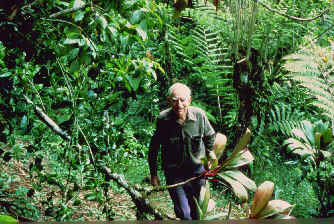
Alexander
Skutch on his Costa Rican property
(photograph by Alan Brady)
Links:
Upcoming
FONT Birding & Nature Tours
in Costa Rica, Panama, Guatemala,
Belize, Honduras, & Mexico
A Central America Bird-List & Photo Gallery, the 1st of 4 Parts
(with links to the others)
Following, in
this file, a list of some birds
in Alexander Skutch writings
During
our FONT Costa Rica Tour in March 2010, we visited, for the first time in
about 10 years, "Los Cosingos", the home of the famed
naturalist Alexander Skutch.
During our tours in the 1980s & 1990s, we had visited the place often. And
since March 2010, we visited during our FONT Costa Rica tours in 2011 &
2012.
Many memories came back to me when we revisited in March 2010. Especially when I
looked at the rooms in his house, and saw so many things just as he had them
there, as he lived simplistically during the decades of the second half of the
20th Century. His clothing was on hangers in his closet. His books, so many of
them, were on the shelves. His old typewriter was there on his desk, as was an
equally old sewing machine nearby. Perhaps all of the letters that he had
received over the years were neatly in piles held together by rubber
bands.
On the outside porch, there were the same chairs where Alexander Skutch and I
sat during my visits in previous years. From those chairs, more than once, we saw a Turquoise
Cotinga perched high in a treetop.
In March 2010, during our morning at "Los Cosingos", when we looked
into that same tall bare tree, there was, incredibly, as blue as could be, once
again, a Turquoise Cotinga!
In was back in of January 2005 when we did our first FONT tour in Costa Rica
after Alexander
Skutch had died the previous year. That time, however, we did not visit the Skutch
property. When we passed through the nearby southern Costa Rican city
of San Isidro de General, it just did not seem the same, for me, to be in that
area, knowing that Mr. Skutch was gone.
A few kilometers west of that city, during that tour, we encountered Fiery-billed
Aracaris. That sighting reminded me again of the homestead, not far away, of
Alexander Skutch, that we did not visit that time, named "Los Cusingos", after a local name for that bird (in the photograph
below).
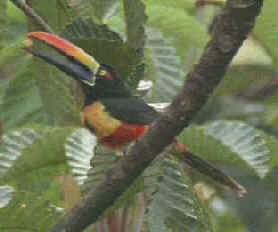
Something
throughout our January '05 tour that couldn't help but be noticed was the large
number of tourists traveling about the country using the book, "A Guide to
the Birds of Costa Rica", co-authored by Alexander Skutch & F. Gary
Stiles.
Also back in 2005, Ken Allaire, of New York, NY, USA, contributed
some more information regarding Alexander Skutch to this feature in our FONT web-site.
From Ken's note, we added to the listing
below another book: "Trogons, Laughing Falcons, and other Neotropical
Birds".
Ken also noted that Skutch's was the only treatment of bill-combat behavior
among aracaris that he has found (in the publication the "Condor"), a
behavior that Ken filmed in Panama.
(A photograph of the Fiery-billed Aracari is above.)
Thanks, Ken, for your contribution, and if anyone else has something that can
be added to this tribute to Dr. Skutch, we'd be appreciative.
The
narrative that follows I wrote in 2004, following the passing of
Alexander Skutch:
In May of 2004, Dr. Alexander
Skutch died. He was nearly 100 years of age. In 1904, he was born in Baltimore,
Maryland.
Back in 1935, he was in Costa Rica. During November of that year, he
stepped off a little trolley in San Jose (Costa Rica's principal city), with a
knapsack on his shoulder, and headed toward a small airport, with a ticket in his
pocket, for a flight to the small southern Costa Rican city of San Isidro de
General. It was near that city where he settled in 1941, naming his farm
"Los Cosingos". And it was to be there that he would live for so many
years, until his death.
In one of his many books, "A Naturalist on a Tropical Farm", published
in 1980, Skutch wrote of the naming of his farm: "After long cogitation, I
called my farm "Los Cusingos", for (the birds) the
Fiery-billed Aracaris, which are found only on the Pacific side of southern Costa Rica and
across the border in Panama. I was not totally satisfied with this choice, but
settled for it because certain other birds that I admired more lacked names that
my neighbors knew and could pronounce. Now I am convinced it was a good choice;
these agile colorful toucans have persisted here, while other, less wary birds
have disappeared."
In 2004, Alexander Skutch was buried at his farm "Los Cusingos".
I had the very good fortunate to visit Dr. Skutch at "Los Cusingos" a
number of times.
My first visit there, with him at his property, was in 1983.
During our FONT Costa Rica tour in 2004, I opted for the first time when with a tour in the area not to
visit. When we were in the Costa Rican mountains, during that tour, I met a young lady from Japan, who,
with a friend from that country, was enjoying the thrill of seeing a male
Resplendent Quetzal. She told me, at the time, that she had just been (as a
visiting naturalist herself) at Dr. Skutch's farm, "Los Cusingos". She
said, sadly, that he really was quite frail.
I remember all of my visits to "Los Cusingos". I always enjoyed the
beautiful place and the wonderful birds.
But I always enjoyed the most my time
with Dr. Skutch. It was more fulfilling for me to sit on a rocking chair on his
porch, and listen to him speak, as others were running around the grounds
looking at the birds.
And I do remember so well one of those times, when, even though it was
mid-day, he excitedly said to look at the bare tree in front of us. A
Turquoise Cotinga was perched there.
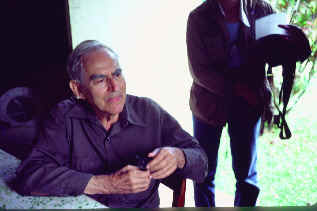
Alexander Skutch in
1983.
(photo by Alan Brady)
Alexander Skutch really was
"A Naturalist in Costa Rica". That was the title of what's probably my
favorite of his books in my library. It was published in 1971, and relates of
some of his tropical travels prior to "Los Cusingos", and then his
settling there in southern Costa Rica. In the book, there are a number of
black-and-white photographs.
That book is divided in two parts:
Part I: "A Naturalist's Wanderings", with these chapters:
Into the Wilderness
Homemaking Amid the Forests
A Fragrant Summit
Two Drops of Blood
Backwoods Neighbors
The Mountain of Death
The Snake Eater
In Quest of the Quetzal
Winding Creek
The Hummingbird's Brook
Los Cusingos
Part II: "A Naturalist's Homestead", with the chapters:
A Farm in the Wilderness
The House
The Garden and Its Birds
The Lives of Some Tropical Flowers
The River
Forest Trails
A Last Home of Mystery
The Coffee Grove
Social Insects, Their Homes and Enemies
Farming Without A Plow
Butterflies and Moths
In the Caribbean Lowlands
Conclusion: Vicissitudes of a Valley
Appendix 1: Birds of Los Cusingos and the Valley of El General
Appendix 2: The Author's Published Writings
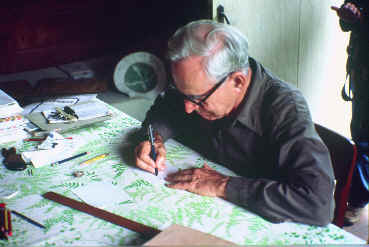
(photograph by Alan Brady in 1983)
Alexander Skutch was a prolific writer about nature, particularly about birds
and other nature of the Neotropics. Back in 1971, in the appendix, just noted, of
"A
Naturalist in Costa Rica", 6 previous books were listed (including his
renowned "Life Histories of Central American Birds" published in 1954
with the Cooper Ornithological Society), as were an incredible 139 articles that
he had written up to that time, beginning in 1926.
I remember when I met with Alexander Skutch in 1999, when he was well into his
nineties, his proudly telling me that he was still writing a book about birds.
(See the note following the first listing of books below.)
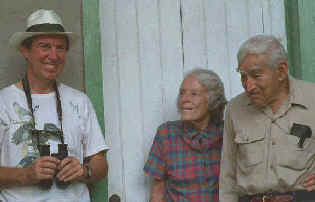
Alexander Skutch
with Mrs. Skutch and Armas Hill of FONT (left)
at the
Skutch's home "Los Cusingos" in Costa Rica
during FONT birding
tour in
March 1999.
So many of Dr. Skutch's writings about birds (mostly tropical birds) I find to
be interesting and informative.
FOLLOWING HERE, IN THIS FEATURE, IS A LISTING OF PARTICULAR BIRD SPECIES,
GROUPS OF BIRDS, AND SOME OTHER WILDLIFE, NOTING AS REFERENCE RELATED WRITINGS
BY DR. SKUTCH.
In those
writings, there's a wealth of well-written information.
That listing will follow here shortly, but first, here's yet another listing - of
books that Alexander Skutch authored, with most of them in my library:
"Life Histories of Central American Highland Birds", 1954,
Univ. of California Press. Also published by the Nuttall Ornithological Club,
Cambridge, Massachusetts, 1967
"A Naturalist in Costa Rica", 1971, Univ. of Florida Press.
"The Imperative Call: A Naturalist's Quest in Temperate and Tropical
America", 1971, Univ. of Florida Press.
"Studies of Tropical American Birds", 1972.
"The Life of the Hummingbird", 1973, by Crown Publishers, Vineyard
Books.
"Parent Birds and Their Young", 1976 & 1979, Univ. of Texas Press.
"A Bird Watcher's Adventures in Tropical America", 1977, Univ. of
Texas Press.
"A Naturalist on a Tropical Farm", 1980, Univ. of California Press.
"New Studies of Tropical American Birds",
1981, Nuttall Ornithological Club.
"Nature through Tropical Windows", 1983, Univ. of California Press.
"Birds of Tropical America", 1983, Univ. of Texas Press.
"Life of the Woodpecker", 1985, Ibis Publishing Co.
"A Naturalist Amid Tropical Spendor", 1987, Univ. of Iowa Press.
"Helpers at Bird's Nests: A Worldwide Survey
of Cooperative Breeding and Related Behavior", 1987, Univ.
of Iowa Press.
"Birds Asleep", 1989, University of Texas Press, illustrated by
N. John Schmitt
"Life of the Tanager", 1989,
Comstock Publishing Associates.
"Life of the Pigeon",
1991, Comstock Publishing Associates.
"Origins of Nature's Beauty",
1992, Univ. of Texas Press.
"Antbirds & Ovenbirds", 1996, Univ. of Texas Press.
"Orioles, Blackbirds, and their Kin",
1996, university of Arizona Press.
"The Minds of Birds",
1996, Texas A&M University Press.
"Life of the Flycatcher", 1997,
Univ. of Oklahoma Press.
"Trogons, Laughing Falcons, and other Neotropical Birds", 1999, Texas
A&M University Press.
A book relating to Alexander Skutch, edited after his death by Hunter Lewis, is
a good read: "Alexander Skutch: An Appreciation", 2004, Axios
Press.
In the preface of the last of Skutch's books noted above, published in 1999, he wrote:
"In this book, probably the last that I shall write about birds, I have
tried to blend entertaining reading with solid natural history, including new
observations of little-known Neotropical birds."
His last words in that book, at the end of the epilogue entitled "The Birds
I Love", were these:
"In childhood I was strongly attracted to feathered creatures. This has
continued into my life's tenth decade. As I review my seventy years of bird
study, nearly all in the Neotropics, I am comforted by remembering that I have
never intentionally harmed, for science or otherwise, an adult bird or its
young, although I was responsible for the deaths of two or three raptors preying
upon birds I was studying and/or trying to protect.
In the evening of life, I am distressed by the thought that humankind, as a
whole, lacks the generosity to freely share an exceptionally favored planet with
even the more compatible of the free creatures that surround us. Earth did not
become habitable for the benefit of a single species."
![]()
In many of Dr. Skutch's books, the drawings and the color illustrations were by
Dana Gardner.
The color illustrations in "The Life of the Hummingbird"
were by Arthur Singer.
Known to many is the excellent "Guide to the Birds of Costa Rica", co-authored by Alexander Skutch and F. Gary Stiles, published in 1989, and used
by many birders visiting Costa Rica during the years since.
There are editions in both English and
Spanish. The color illustrations are by Dana Gardner.
Dr. Skutch was surely
responsible for much of the good background information in that book relating to
the nests and habits of the birds.
Some notable chapters in some of Skutch's books
include:
In "A Bird Watcher's Adventures in Tropical America", 1977:
Through Mexico by Train
Birds on a Guatemalan Mountain
Among Ecuadorian Forests
Through Peruvian Amazonia by Gunboat
The Emerald Land
Bird Watching during a Revolution
The Most Hospitable Tree
Birds on a Venezuelan Farm
Birds and Ants
The Dawn Songs of Tropical Birds
Epilogue: The Appreciative Mind
Some photographs in
Costa Rica in 1978,
by Armas Hill
![]()
Birds
and Other Wildlife
in the Writings of
Alexander Skutch
found during FONT tours in:
BR: Brazil BZ: Belize CR: Costa Rica
GU: Guatemala
HN: Honduras MX: Mexico PN: Panama
Birds:
Great
Tinamou: a chapter about it in the "Birds of Tropical America"
______ CR, GU, HN, MX, PN
Little
Tinamou: a chapter about it in the "Birds of Tropical America"
______ CR, HN, PN
Gray-headed
Chachalaca: a chapter about it in the "Birds of Tropical America",
and another chapter about it, entitled "Living with Chachalacas",
in "Trogons, Laughing Falcons, and Other Neotropical Birds" ______
CR, PN
Horned Guan: a
chapter about it, entitled "The Endangered Horned Guan", in
"Trogons, Laughing Falcons, & Other Neotropical Birds" ______
GU
This species occurs only locally on
high mountains in Guatemala & in Chiapas in southern Mexico.
(photo below, of this, one of the rarest birds seen during FONT tours)
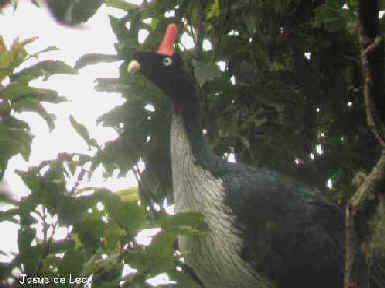
Crested Guan:
in a chapter, entitled "The Sound of Wings", in "Trogons,
Laughing Falcons, & Other Neotropical Birds" ______ CR, GU, PN
(photo below taken during a FONT
tour)

Black Guan: in
a chapter, entitled "The Sound of Wings", in "Trogons,
Laughing Falcons, & Other Neotropical Birds" ______ CR
This species occurs at high
elevations in Costa Rica & western Panama.
Marbled
Wood Quail: a chapter about it in the "Birds of Tropical America"
______ CR, PN
Black-breasted
Wood Quail: a chapter about it, entitled "Glimpses of Wood
Quails", in "Trogons, Laughing Falcons, & Other Neotropical
Birds" ______ CR
Spotted Wood
Quail: referred to in a chapter, entitled
"Glimpses of Wood Quails", in "Trogons, Laughing Falcons,
& Other Neotropical Birds" ______ CR, GU
Laughing
Falcon: a chapter about it, entitled
"Snake Eaters in a Garden", in "Trogons, Laughing Falcons,
and Other Neotropical Birds" ______ BR, BZ, CR, GU, HN, MX, PN
A local
Costa Rican name for this bird is the "Guaco".
(photo below taken during a FONT tour)
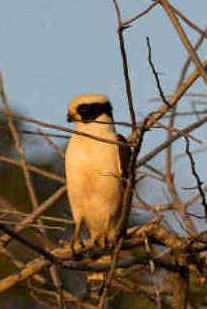
Swallow-tailed
Kite: referred to in a chapter, entitled "Three Flycatching
Kites", in "Trogons, Laughing Falcons, and Other Neotropical
Birds". The material is largely from an article by Skutch in the
journal "The Condor' in 1965. ______
BR, CR, GU
(photo below)
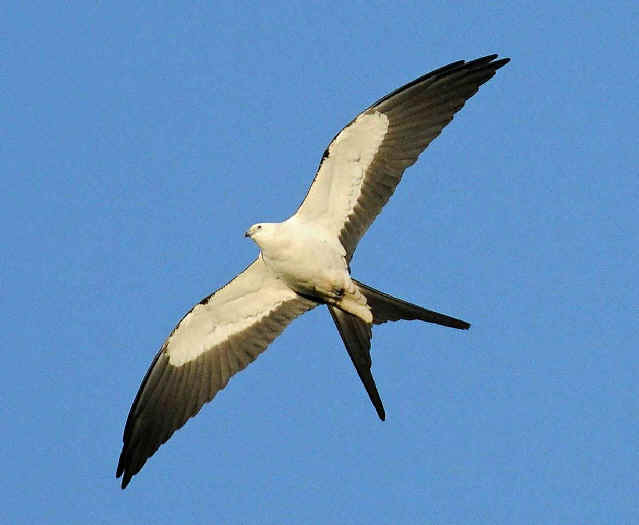
Plumbeous
Kite: referred to in a chapter, entitled "Three Flycatching Kites:, in
"Trogons, Laughing Falcons, and Other Neotropical Birds". The
material is largely from an article by Skutch in the journal "The
Condor" in 1947. ______
BR, CR, GU
Double-toothed
Kite: referred to in a chapter, entitled "Three Flycatching
Kites", in "Trogons, Laughing Falcons, and Other Neotropical
Birds". The material is largely from an article by Skutch in the
journal "The Condor" in 1965. _____
CR
Gray-necked
Wood Rail: a chapter about it in "A Naturalist on a Tropical Farm", entitled
"The Singing Wood-Rail" ______ BR, CR, GU, HN, MX, PN
(photo below taken during a FONT tour)
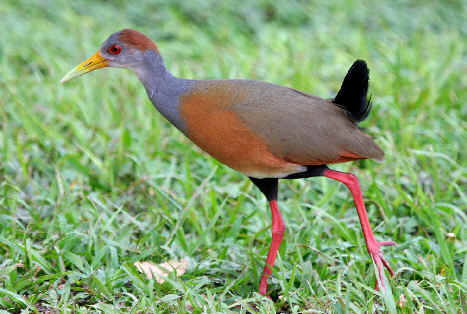
Scaled
Pigeon: a chapter about it in the "Birds of Tropical America"
______ BR, CR, GU, MX, PN
Red-billed
Pigeon: a chapter about it in the "Birds of Tropical America"
______ CR, GU, HN, MX
Short-billed
Pigeon: a chapter about it in the "Birds of Tropical America"
______ BZ, CR, GU, HN
Band-tailed
Pigeon: a chapter about it in the "Birds of Tropical America" ______
CR, GU, PN
(photo below)
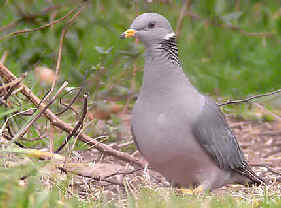
White-winged
Dove: a chapter about it in the "Birds of Tropical America"
______ BZ, CR, GU, HN, MX
(photo below)
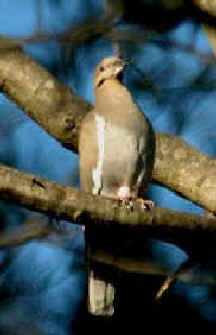
Ruddy
Ground Dove: a chapter about it in the "Birds of Tropical America"
______ BZ, CR, GU, HN, MX, PN
White-tipped Dove: a
chapter about it, entitled "A Valiant Dove" in "A Naturalist
Amid Tropical Splendor" _____ BR, BZ, CR, GU, HN, PN
"Rufous-naped
Dove": referred to in the chapter
"A Valiant Dove" in "A Naturalist Amid Tropical
Splendor" ______ CR, PN
This bird is the Pacific race, in southern Costa Rica & adjacent
Panama, of the Gray-chested Dove, Leptotila cassini.
Squirrel
Cuckoo: a chapter about it in the "Birds of Tropical America"
______ BZ, CR, GU, HN, PN
(photo below)
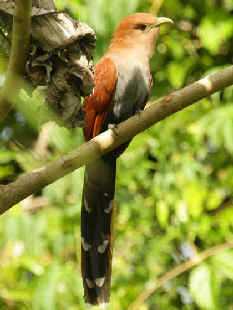
Lesser
Ground-Cuckoo: a chapter about it in the "Birds of Tropical America"
______ CR, GU
Striped
Cuckoo: a chapter about it, referring to its parasitism, in "Trogons,
Laughing Falcons, and Other Neotropical Birds" ______
BR, CR
Groove-billed
Ani: a chapter about it in the "Birds of Tropical America" (particularly
interesting) ______ BZ, CR,
GU, HN, MX, PN
(in the photos below, during FONT tours; the lower photo with cattle in
northwestern Costa Rica)
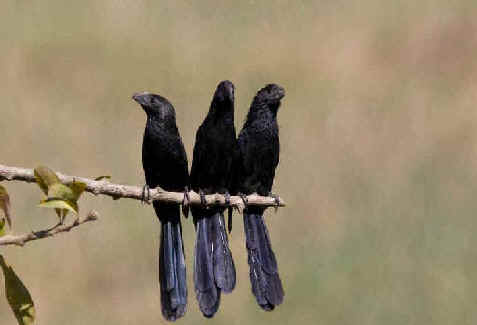
Common Potoo: a chapter about it in the "Birds of Tropical America"
______ BR, CR
This species nested not far from Skutch's home in southern Costa
Rica.
(in the photo below, a mother & a very young bird; photo by Ruben
Campos)
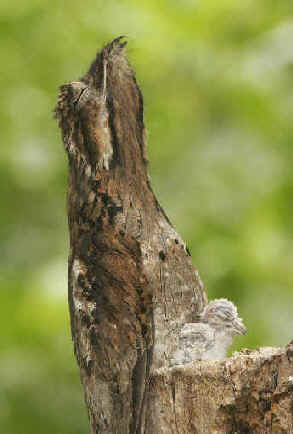
Hummingbirds:
a chapter in "A Bird Watcher's Adventures in Tropical
America",
entitled "The Charm of Hummingbirds" ______
the
hummingbirds called Hermits: a chapter in "A Naturalist on a Tropical
Farm", entitled "Scarlet Passion-flowers and Hermit Hummingbirds"
______ CR
Long-billed Hermit
(in
Central America; was conspecific with the Long-tailed Hermit of northern
South America): a chapter about it in "Trogons, Laughing Falcons, and
Other Neotropical Birds". Much of this chapter is from what was in a
paper by Skutch in the journal "The Auk" in 1964. ______ CR
Stripe-throated
(formerly
Little) Hermit: a chapter
about it in "Nature through Tropical
Windows" ______ CR
(in photo below, at a nest in Costa Rica; photo by Alan Brady)
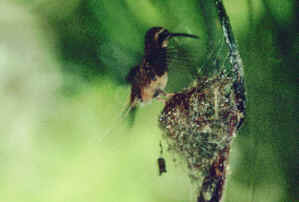
Scaly-breasted Hummingbird: a
chapter about it in "A Naturalist Amid Tropical Splendor" (this
species is in the genus Campylopterus; all of the others in that
genus are called "Sabrewings") _____ CR, GU, HN,
PN
Violet-headed
Hummingbird:
a chapter about it in "Trogons, Laughing Falcons, and
Other Neotropical Birds". This chapter is with more material than what
was originally in Skutch's paper about the bird in "The Wilson
Bulletin" in 1958. ______
CR
(photo below by Marie Grenouillet)
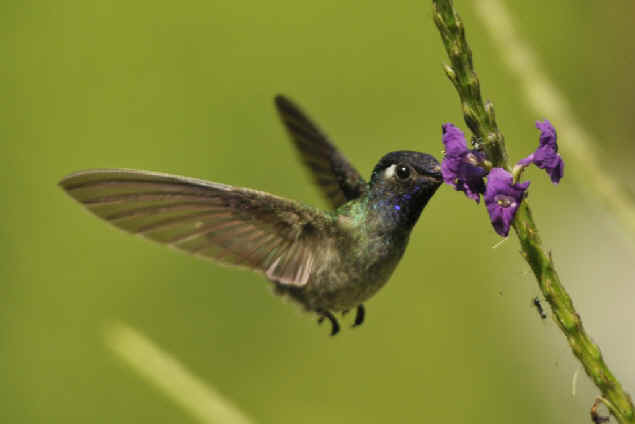
White-crested
Coquette: a chapter about it in "Nature through Tropical Windows"
______ CR
White-eared
Hummingbird:
a chapter about it, entitled "The Tinkling
Hummingbird" in "Trogons, Laughing Falcons, and Other Neotropical
Birds". Parts of this chapter were contributed to A. C. Bent's
"Life History of North American Cuckoos, Goatsuckers, Hummingbirds, and
Their Allies", published in 1940. ______ GU
(photo below taken during a FONT tour)
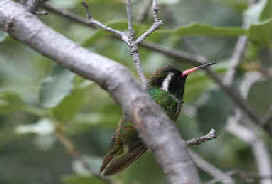
Purple-crowned
Fairy: a chapter about it, entitled "A Charming Thief", in
"A Naturalist Amid Tropical Splendor" _____ CR, GU, HN, PN
Long-billed
Starthroat: a chapter about it in
"Trogons, Laughing Falcons, and Other Neotropical Birds" and
referred to in a chapter,
entitled "A Charming Thief", in "A Naturalist Amid Tropical
Splendor" _____ BR, CR, GU,
PN
Broad-tailed
Hummingbird: referred to in a chapter, entitled "The Sound of
Wings", in "Trogons, Laughing Falcons, and Other Neotropical
Birds" _____ GU
(photo below)

Costa's
Hummingbird: referred to in a chapter, entitled "The Sound of
Wings", in "Trogons, Laughing Falcons, and Other Neotropical
Birds" _____
(photo below)
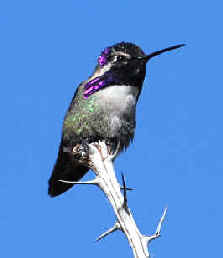
Black-headed
Trogon: a chapter about it in the "Birds of Tropical America"
______ BZ, CR, GU, HN, MX
(photo below taken during a FONT tour)

Gartered Trogon
(in Central America; was conspecific with the Violaceous Trogon
of South America):
in a chapter, entitled
"Beauty with a Handicap" in "Trogons, Laughing Falcons, and
Other Neotropical Birds" _____ GU, MX
Baird's
(or Vermilion-breasted) Trogon: a chapter
about it in the "Birds of Tropical
America" ______ CR
This species is nearly endemic to the Pacific side of southern
Costa Rica.
Mountain
(or Mexican) Trogon:
a chapter about it in the "Birds of Tropical America"
______ GU
A species in the highlands of Guatemala.
Black-throated
Trogon: a chapter about it in the "Birds of Tropical America"
______ BR
This species ranges from Honduras to Argentina.
Collared
Trogon: a chapter about it in the "Birds of Tropical America"
______ CR, GU, HN, PN
Orange-bellied
Trogon: in the chapter re the Collared Trogon in the "Birds of Tropical
America" ______ CR
This bird is often considered to be a subspecies of the Collared
Trogon.
Slaty-tailed
Trogon: in a chapter, entitled "Beauty with a Handicap",
in "Trogons, Laughing Falcons, & Other Neotropical Birds"
______ CR, GU, PN
Resplendent
Quetzal: chapters about it in "Birds of Tropical America"
and in "A Naturalist in Costa Rica"; the latter entitled "In
Quest of the Quetzal" (both chapters with a lot of good info)
______ CR, GU, HN, PN
(photo below)
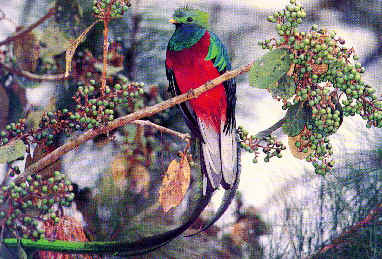
Amazon
Kingfisher: a chapter about it in the "Birds of Tropical America"
______ BR, BZ, CR, GU, HN, PN
Green
Kingfisher: a chapter about it in the "Birds of Tropical America" ______
BR, BZ, CR, GU, HN, PN
(photo below taken during a FONT tour)
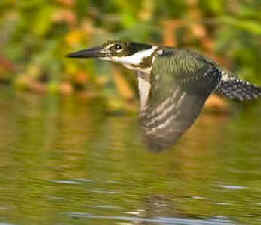
Turquoise-browed
Motmot: a chapter about it in the "Birds of Tropical America" ______
CR, GU, HN, MX
(photo below)
Broad-billed
Motmot: a chapter about it in the "Birds of Tropical America"
______ CR, PN
Rufous
Motmot: a chapter about it in the "Birds of Tropical America"
______ CR, PN
Blue-crowned
Motmot
(or "Blue-diademed Motmot"): a chapter
about it in the "Birds of Tropical America" ______ BR, CR,
GU,
HN, MX, PN
(photo below)
Blue-throated
(Green) Motmot: a chapter about it in the "Birds of Tropical America"
______ GU
This species occurs in the mountains of Guatemala and Honduras.
Rufous-tailed
Jacamar: a chapter about it in the "Birds of Tropical America"
______ BR, CR, GU
(photo below taken during a FONT tour)
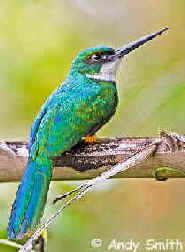
Puffbirds
(particularly the
White-whiskered Puffbird
or
Softwing):
a chapter about them in "A Naturalist on a Tropical
Farm", entitled "The
Patient Puffbirds" ______ CR, GU, PN
Black-breasted
Puffbird: a chapter about it in the "Birds of Tropical America"
______ PN
This species occurs in the former Canal Zone in Panama.
White-fronted
Nunbird: a chapter, filled with information, in "Studies of Tropical
American Birds" ______ CR
Prong-billed
Barbet: a chapter about it in the "Birds of Tropical America"
______ CR, PN
Keel-billed
Toucan (or Rainbow-billed Toucan):
a chapter about it in the "Birds of Tropical America" ______
BZ, CR, GU, HN, PN
(photo below taken during a FONT tour)
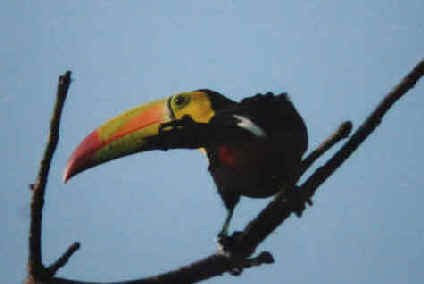
Collared
Aracari: a chapter about it in the "Birds of Tropical America" ______
BZ, CR, GU, HN, PN
(photo below)
Fiery-billed
Aracari: a chapter
about it in the "Birds of
Tropical America" ______ CR
The local Costa Rican for these birds are "Los Cosingos",
the name that Alexander Skutch gave to his homestead.
(photo below taken during a FONT tour)

Emerald
Toucanet: a chapter about it in the "Birds of Tropical America" ______
CR, GU, PN
(photo below)
Golden-naped
Woodpecker: a chapter about it in "A Naturalist on a Tropical
Farm", entitled
"Family Life of the Golden-naped Woodpecker"
______ CR
This species occurs on the Pacific side of southern Costa Rica
and in adjacent Panama.
(photo below)
Orange-collared
Manakin:
referred to in a chapter, entitled "The Sound of Wings",
in "Trogons, Laughing Falcons. and Other Neotropical Birds" ______
CR
Red-capped
Manakin:
referred to in a chapter, entitled "The Sound of Wings",
in "Trogons, Laughing Falcons, and Other Neotropical Birds" ______
CR
(photo below)
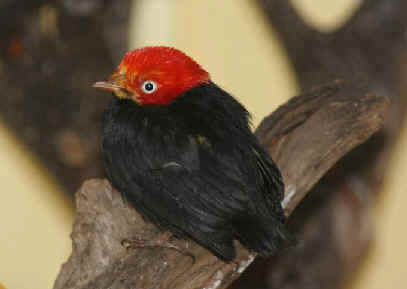
Cotingas:
a chapter in "A Bird Watcher's Adventures in Tropical America", entitled
"The Cotingas: A Study in Contrasts" ______
Yellow-billed
Cotinga:
referred to in a chapter, entitled "The Sound of Wings",
in "Trogons, Laughing Falcons, and Other Neotropical Birds" _____
CR
Lovely
Cotinga:
referred to in a chapter, entitled "The Sound of Wings",
in "Trogons. Laughing Falcons, and Other Neotropical Birds" _____
HN
Turquoise
Cotinga:
referred to in a chapter, entitled "The Sound of Wings",
in "Trogons, Laughing Falcons, and Other Neotropical Birds" _____
CR
(photo below)
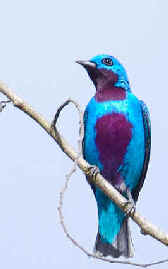
Rufous Piha:
a chapter about it, entitled "When Less Yields More", in
"Trogons. Laughing Falcons, and Other Neotropical Birds". This
chapter is from Skutch's account of the species in volume 3 of "Life
Histories of Central American Birds" , published by the Cooper
Ornithological Society in 1969 and now difficult to obtain. ______
CR
Piratic Flycatcher:
referred to in
a chapter, entitled "A Paradoxical Relationship", in
"Trogons, Laughing Falcons, and Other Neotropical Birds" ______
BR, CR, MX
Gray-capped
Flycatcher:
referred to in a chapter, entitled "A Paradoxical
Relationship", in "Trogons, Laughing Falcons, and Other
Neotropical Birds" ______
CR
Social (or
Vermilion-crowned) Flycatcher: referred to in a chapter, entitled "A
Paradoxical Relationship", in "Trogons, Laughing Falcons, and
Other Neotropical Birds" ______
BR, CR, MX
(photo below, by Alan Brady)
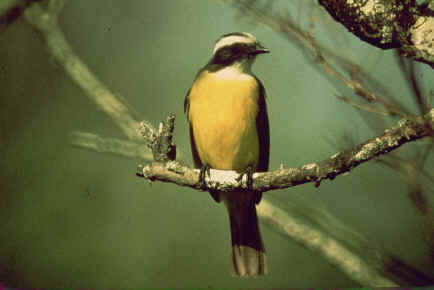
Boat-billed
Flycatcher: a chapter about it in "Nature through Tropical Windows"
______ BR, CR
Great Kiskadee:
a chapter about it,
entitled "A Versatile Flycatcher", in "Trogons. Laughing
Falcons, and Other Neotropical Birds" _____
CR, GU, MX, PN
(photo below taken during a FONT tour)
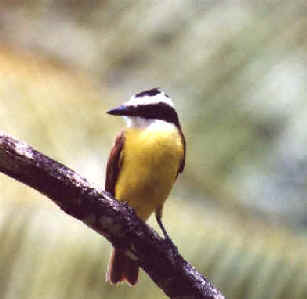
Eastern
Kingbird:
referred to in a chapter, entitled "The Strenuous Lives of
Migratory Birds", in "Trogons, Laughing Falcons, and Other
Neotropical Birds" ______ CR, GU, HN,
PN
(photo below)
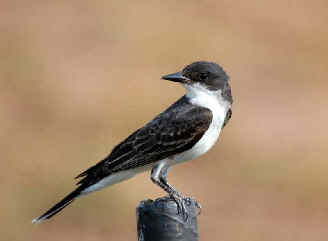
Bicolored
Antbird: a chapter about it in "A Naturalist on a Tropical Farm"
______ CR, PN
Black-faced
Antthrush: a chapter about it in "Antbirds & Ovenbirds"
______ CR, PN
Horneros:
referred
to in a chapter entitled "Castlebuilders" in "A Naturalist
Amid Tropical Splendor" _____ BR
(photo below of a Rufous
Hornero during a FONT tour; due to its nest, the bird is known as an "Ovenbird")
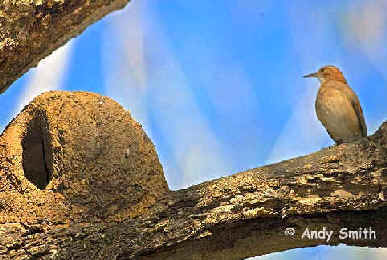
Rufous-breasted
Spinetail (or "Rufous-tailed Castlebuilder"):
in a chapter entitled "Castlebuilders"
in "A Naturalist Amid Tropical Splendor" _____ GU
This species occurs in the lowlands of southern Mexico &
northern Central America, south to Honduras & El Salvador.
Slaty
Spinetail (or "Slaty Castlebuilder"): in
a chapter entitled "Castlebuilders" in "A Naturalist Amid
Tropical Splendor" ______ CR
This species occurs in southern Central America, and south through
Colombia to western Ecuador.
Pale-breasted
Spinetail (or "Pale-breasted Castlebuilder"):
referred to in a chapter entitled
"Castlebuilders" in "A Naturalist Amid Tropical
Splendor" ______ BR, CR, PN
This species is widespread in South America from central Argentina
to the Caribbean coast, and north into Central America to the Terraba Valley
in southern Costa Rica.
Rufous-fronted
Thornbird: referred to in a chapter
entitled "Castlebuilders" in "A Naturalist Amid Tropical
Splendor" ______ BR
(photo below taken during a FONT
tour)
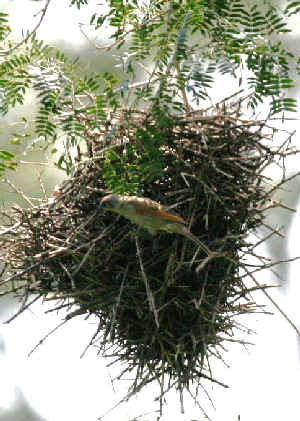
Woodcreepers:
a chapter about them in "A Bird Watcher's Adventures in Tropical
America", entitled
"The Woodcreepers of Tropical America" ______
Long-tailed
Silky-Flycatcher: a
chapter about it, entitled "A Bird of Stormy Heights", in "A
Naturalist Amid Tropical Splendor" _____ CR
The range of this species is
restricted to parts of central & southern Costa Rica and adjacent
western Panama.
(photo below, by Ruben Campos)
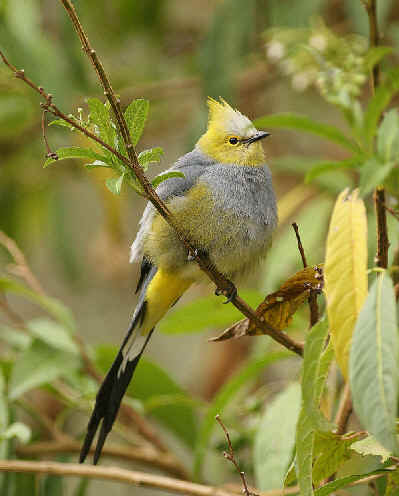
Blue-and-white
Swallow: a chapter about it in "Nature through Tropical Windows"
______ BR, CR, PN
the
House Wren: two chapters about it in "Nature through Tropical
Windows", relating respectively to the bird's first-year &
second-year ______ BR, BZ, CR, GU, HN, PN
(photo below of a "Southern House Wren", taken during a
FONT tour)
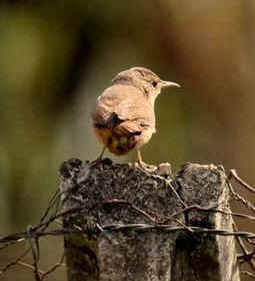
Black-capped
Donacobious: a chapter about it, entitled "A South
American Marsh Bird", in "A Naturalist Amid Tropical
Splendor" ______ BR
(photo below taken during a FONT tour)
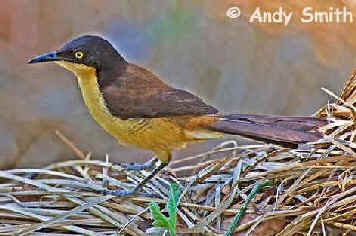
Blue-and-white
Mockingbird: a chapter about it, entitled
"A Mockingbird in Blue", in "A Naturalist Amid Tropical
Splendor" ______ GU
Euphonias: a
chapter about some of them in "A Naturalist Amid Tropical
Splendor". Those referred to in that chapter are:
Yellow-throated Euphonia ______
BZ, CR,
GU, HN
Elegant (formerly Blue-hooded) Euphonia ______
CR, GU, PN
White-vented Euphonia ______ CR
Trinidad Euphonia ______
Spot-crowned (or "Tawny-bellied")
Euphonia ______
CR, PN
Olive-backed Euphonia ______
CR, GU, HN,
PN (in the photo below)
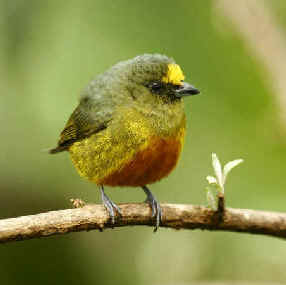
Violaceous Euphonia ______
Thick-billed Euphonia ______
CR, PN
Yellow-crowned Euphonia ______ CR, PN
(in
the photo below)
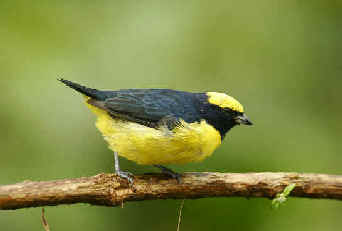
Golden-browed Chlorophonia
______ CR, PN
Euphonias
have long been classified as tanagers. In fact, the chapter
about them in Skutch's book, "A Naturalist Amid Tropical Splendor"
is entitled "The Smallest Tanagers".
Now, however, these birds have been put into the Finch family.
Taxonomically, both the Euphonias & the
Chlorophonias are placed there just before the Greenfinches,
Siskins, and Goldfinches.
Montezuma
Oropendola:
a chapter about it, entitled "A Village in a Treetop", in
"A Naturalist Amid Tropical Splendor" _____ BZ,
CR, GU, HN, MX, PN
(this Central American species has recently extended its range as far
south as the Panama Canal)
(photo below taken during a FONT tour)
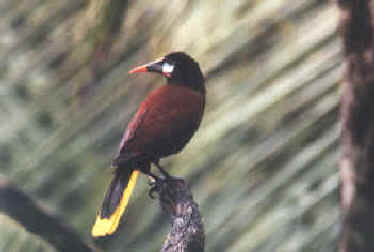
Oriole
Blackbird: a chapter about it in "A
Naturalist Amid Tropical Splendor" ______ BR
Giant
Cowbird: referred to a a chapter,
entitled "A Village in a Treetop", in "A Naturalist Amid
Tropical Splendor" _____ BR, CR, GU, HN, PN
Bananaquit:
a chapter about it in "Nature through Tropical Windows" ______
BR, BZ, CR, MX, PN (also tours in the West Indies)
(photo below)
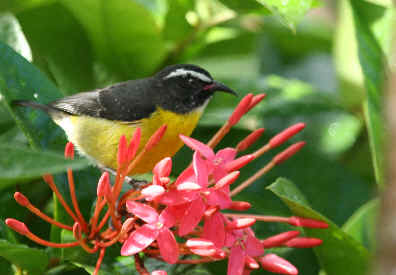
Black-striped
Sparrow: a chapter about it in "Nature through Tropical Windows"
______ CR
Speckled
Tanager: a chapter about it in "A Naturalist on a Tropical Farm"
______ CR
(photo below, by Ruben Campos)
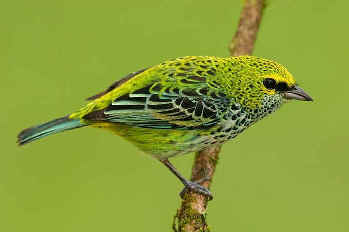
Rosy
Thrush-Tanager: a chapter about it, entitled "The Elusive Queo",
in "A Naturalist Amid Tropical Splendor" ______ PN
Grayish Saltator: a chapter
about it, entitled "A Melodious Saltator", in "Trogons,
Laughing Falcons, and Other Neotropical Birds" ______
BZ, CR, GU, HN, MX
MAMMALS:
Golden Lion Tamarin,
Leontopithecus rosalia: referred to in a chapter, entitled "The
Birdlike Monkeys", in "Trogons, Laughing Falcons, and Other
Neotropial Birds" ______
Silvery Marmoset
(&
Buffy-tufted Marmoset), Callithrix argentata (& Callithrix aurita):
referred to in a chapter, entitled "The Birdlike Monkeys", in
"Trogons, Laughing Falcons, and Other Neotropical Birds" ______ BR
(the Buffy-tufted Marmoset)
(photo below, taken during a FONT tour)

Golden-headed
(or Gold-and-Black) Lion Tamarin, Leontopithecus chrysomelas:
referred to in a
chapter, entitled "The Birdlike Monkeys", in "Trogons,
Laughing Falcons, and Other Neotropical Birds" ______
(photo below)

Golden-mantled Tamarin,
Saguinus tripartitus: referred to in a chapter, entitled "The Birdlike
Monkeys", in "Trogons, Laughing Falcons, and Other Neotropical
Birds" ______
Pied Bare-faced Tamarin,
Saguinus bicolor: referred to in a chapter, entitled "The Birdlike
Monkeys", in "Trogons, Laughing Falcons, and Other Neotropical
Birds" ______
Red-handed
(or Golden-handed,
or Midas) Tamarin, saguinus midas:
referred to in a chapter, entitled
"The Birdlike Monkeys", in "Trogons, Laughing Falcons, and
Other Neotropical Birds" ______
Cotton-top Tamarin,
Saguinus
oedipus: referred to in a chapter, entitled "The Bidlike Monkeys",
in "Trogons, Laughing Falcons, and Other Neotropical Birds" ______
Buffy-headed
(formerly Tufted-eared) Marmoset, Callithrix flaviceps:
referred to in a chapter,
entitled "The Birdlike Monkeys", in "Trogons, Laughing
Falcons, and Other Neotropical Birds" ______
Emperor Tamarin,
Saguinus
imperator: referred to in a chapter, entitled "The Birdlike
Monkeys", in "Trogons, Laughing Falcons, and Other Neotropical
Birds" ______
Saddle-backed Tamarin,
Saguinus fuscicollis: referred to in a chapter, entitled "The Birdlike
Monkeys", in "Trogons, Laughing Falcons, and Other Neotropical
Birds" ______
Black-chested Moustached
Tamarin, Saguinus mystax: referred to in a chapter, entitled "The
Birdlike Monkeys", in "Trogons, Laughing Falcons, and Other
Neotropical Birds" ______
Dusky Titi
(now split in
various species), in the genus Callicebus: referred to in a chapter,
entitled "The Birdlike Monkeys", in "Trogons, Laughing
Falcons, and Other Neotropical Birds" ______ BR
(the Masked Titi)
Squirrel Monkeys
(now 5
species in Central & South America), in the genus Saimiri:
referred to
in a chapter, entitled "The Birdlike Monkeys", in "Trogons,
Laughing Falcons, and Other Neotropical Birds" ______ CR
(the Central American Squirrel Monkey)
(photo below, taken during a FONT tour)
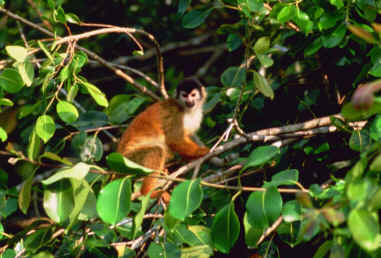
![]()